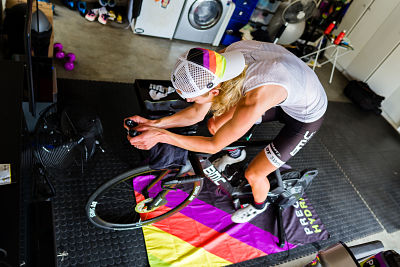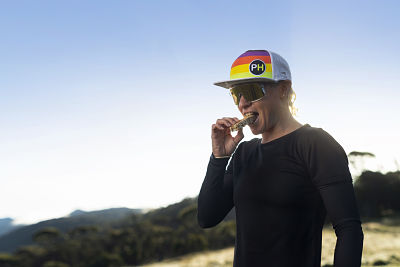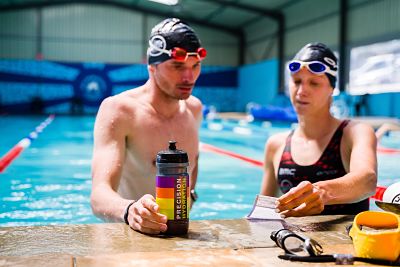In response to our athlete case studies which analyse fluid, sodium and carb consumption during various endurance events, people often ask how some athletes can routinely tolerate drinking considerably more than 500ml (~16oz) of fluid per hour when competing.
So, let’s dive in and see what the science says…
How much do elite athletes drink during competitions?
We can see from the data we’ve collected in our case studies that 63% of the triathletes we’ve studied have consumed more than 500ml (~16oz) of fluid per hour on average across their race.
And it’s not only in triathlon where we see these high numbers being hit; Malcolm Hicks, an Olympic marathon runner who competed in Tokyo, drank an average of 1.1L (37oz) of fluid each hour across the hot and humid race. This was matched by ultra runner Pierre Meslet during the Marathon des Sables, who comfortably drank more than 1L/hr (34oz/hr) for three of the six stages when temperatures were pushing 50℃ (122°F).
Based on the questions coming in, it seems as if it’s not unusual for athletes to struggle to drink these kinds of volumes themselves. Common complaints revolve around fluid accumulating in the stomach, causing bloating or sloshing, and this seems especially prevalent during high intensity or very prolonged exercise in hot conditions.
Whilst it’s important to emphasise that more isn’t always better when it comes to how much you drink in a race (your fluid intake should always be somewhat proportional to and less than your sweat losses), learning to drink large quantities is an appealing notion for athletes with large sweat rates who compete in longer events in hot or humid conditions.
This is because, for a number of these individuals, dehydration can be one of the most significant performance limiters and one that needs to be addressed if they’re to perform at their best.
Take pro triathlete Emma Pallant-Browne, for example. She’s collected her sweat rate data in different sessions over a number of years and has a very high sweat rate (she can lose up to 2.5 litres / 85oz of sweat per hour in hot conditions).
In response to this, she regularly aims to consume ~800ml/hr (~27oz) on the bike leg of an IRONMAN 70.3, whilst averaging ~700ml/hr (~24oz) across the entire race and still finishes with a considerable fluid deficit.

In another example, we’ve worked with a top-tier professional tennis player in recent years whose sweat rate tops out at over 3 litres(!) per hour. (Yes, we had to get them to measure this quite a few times to confirm it wasn’t a mistake!)
This individual is able to, and in fact seems to need to, consume well over 1.5 litres (61oz) per hour during long matches in hot climates in order to prevent dehydration and cramps derailing his performance.
These levels of fluid intake seem very high (and they’re definitely on the more extreme end of what we see in practice), but clearly they’re attainable and it seems like a number of athletes really do need to hit these sort of numbers in order to maintain their performance.
So, if you think you might be someone who needs to increase your level of fluid intake, how can you achieve this?
The dangers of overdrinking
Before we go on, it’s worth noting that this article definitely isn’t written to promote the idea that trying to learn to drink more fluid is something that applies to all athletes in all conditions. In many circumstances, excessive overdrinking can actually be far more dangerous than slightly under drinking, and so context is key.
Learning to tolerate more fluid intake is something that can benefit those with very high sweat losses who are also competing in longer and hotter events, where dehydration is a major performance limiter. Consider this when evaluating whether the information here applies to you and your individual circumstances. If it helps, you can always book a free video consultation with us to chew the fat on this…
How to increase your ability to drink more fluid during exercise
When we talk about drinking to replace a proportion of your sweat losses, the end goal is to get water back into your bloodstream (which is where your sweat is drawn from in the first place) in order to maintain your blood plasma volume, which in turn supports ongoing cardiovascular effort.
In order for the fluids you drink to get into your blood, they must first pass through from the gastrointestinal system and be absorbed (predominantly) via the wall of your small intestine.
Upstream of the small intestine, your stomach acts as the gatekeeper and fluid must first empty from here before it can be absorbed into your vascular system.
To maximise the delivery of fluid to your blood and to improve your ability to tolerate a greater volume of fluid, there are a few things you can do:
- Gradually increase the volume of fluid you’re consuming to leverage your stomach’s ability to adapt
- Drink hypotonic sports drinks to encourage increased absorption through your gut wall
- Test drinking more, less frequently to optimise your gastric emptying rate
Let’s dive into each of these 3 in more detail...
1. Increasing fluid consumption to encourage your stomach to adapt
There’s substantial anecdotal evidence that your stomach can adapt to ingesting large volumes of fluid, solids or combinations of the two.
Some of the best insights into this phenomenon come from the weird world of competitive eating and how participants prepare themselves for the all-you-can-eat challenges they take on.
Your stomach is surrounded by muscles that contract and then relax to help move digesting food along. It’s possible to strengthen these muscles and to force them to relax (expand) further.
Competitive eaters are known to ‘train’ their stomachs by drinking increasing volumes of fluid over a number of weeks and then moving onto softer foods and graduating to solid foods closer to competition.
The effect of this training regime is two-fold; first, the stomach can literally be taught to expand and contain more food, and second, it can more easily tolerate a large fluid load and reduce the perception of fullness or discomfort associated with drinking a lot.
This shouldn’t be all that surprising; most aspects of physiology respond to challenges by adapting in one way or another, so slowly dialling up your intake of fluid during exercise over a period of days and weeks is likely to make it easier to tolerate more.
In this way, it’s a similar concept to training the gut to tolerate more carbohydrate - a practice that’s getting more and more attention from elite athletes these days.

In research terms, there’s some evidence that supports the idea that repeated bouts of training whilst ingesting large amounts of fluid can increase GI comfort levels.
A group of scientists in the USA asked a group of runners to run five times for 90 minutes in 25℃ (~77F) heat whilst drinking an electrolyte-carb drink at a rate equivalent to their sweat losses.
For many of the runners, this was a very large amount to take in and it caused some discomfort during the first couple of runs. But stomach comfort ratings improved significantly as the sessions progressed and the participants were able to tolerate more by the fourth and fifth runs.
It was theorised that this was caused by the stomach adapting and extending its walls, allowing greater space for fluid, backing up the anecdotal reports from competitive eaters and their somewhat less scientific training regimes.
2. Drink a hypotonic sports drink to maximise absorption
Fluid exits the small intestine via osmosis, as well as via a number of transporter proteins in the wall of your gut. Think of these as gateways. These gateways can be opened in the presence of certain molecules.
It’s well known that the inclusion of some glucose and sodium in fluid drives greater absorption of fluid across the gut as a result of it ‘opening’ the SGLT-1 protein transporter.
This is why quality sports drinks often contain a mixture of glucose and sodium, they want to take advantage of this channel into the body. That's why our all-natural drink electrolyte drink mixes contain a small amount of carbohydrate...
The amount of sugar component in a drink is very important here. The recommendation is to consume hypotonic sports drinks rather than isotonic or hypertonic blends during endurance activities, especially in the heat, when your aim is to maximise the absorption of fluid.
This is because hypotonic drinks (as found in the Precision Hydration range) contain enough carbohydrate and sodium to stimulate absorption into your bloodstream without overwhelming your gut with excess sugars, or causing absorption of fluid to be slowed down; something that happens a lot during long races in the heat (causing large amounts of GI distress) if high volumes of more concentrated drinks are consumed for hours on end.
The bottom line when it comes to fluid composition is that hypotonic solutions containing a little glucose and plenty of sodium are almost always likely to be the best option when your aim is to maximise fluid uptake.
3. Test drinking more, less frequently (instead of ‘little and often’) to marginally increase your gastric emptying rate
A third (and arguably more marginal) consideration when seeking to maximise your drinking ability is that the volume and frequency of consumption can exert some influence on your gastric emptying rate.
A study in 2020 took 12 well-trained male runners and had them run for 100 minutes at a steady submaximal pace on two occasions. During both trials, subjects consumed a carb drink mix either as 200ml servings every 20 minutes, or in 50ml servings every 5 minutes.
In other words, the total amount of fluid and carbohydrate consumed was the same, but the way in which it was introduced to the gut varied.
The main aim of the study was to determine whether the timing of carbohydrate intake had any effect on carbohydrate oxidation rate (i.e. how quickly the body uses carbohydrate during exercise).
There were no statistically significant differences between total carbohydrate oxidation in the two groups, but it did seem that drinking slightly larger volumes of fluid (200ml) less often was marginally better at increasing peak carbohydrate oxidation rate than smaller, more frequent drinks.
The explanation for this effect was that gastric emptying may be faster if there is a slightly larger volume in the stomach.
Of course, increased gastric emptying may not be the rate limiting factor in getting more fluids into the bloodstream, but there’s a suggestion that drinking bigger amounts less frequently (vs just taking small sips, very often) might have some effect.
Whether or not this effect is meaningful enough to counteract any discomfort associated with drinking more fluid in one go is probably something that would need to be tested with trial and error in your own training, as it seems like something that could be very individual!

A progressive approach to fluid intake
More fluid isn’t always better when it comes to intake during exercise. But, in cases where sweat losses are very high (and especially during prolonged events in the heat), some athletes can almost certainly benefit from training to increase their fluid intake in order to help them stave off dehydration.
The most effective strategy for anyone trying to increase the amount of fluid they can comfortably drink without experiencing bloating or sloshing is to train with progressively higher volumes if consumption over time to push the stomach to adapt so that feelings of fullness and bloating are reduced.
This process should be undertaken very carefully, progressively and in proportion to your sweat rate.
Typically, higher fluid intakes will only be required when working hard in warm or hot conditions and for prolonged durations. It’s therefore not advisable to be over ambitious in practicing this in cooler conditions, or during sessions where your sweat losses are not that high, as it could result in fluid overload or hyponatremia.
Alongside progressively increasing the amount you’re drinking during sessions, manipulating the composition of your fluids and the acute volumes you’re drinking can also play a role in how much you can consume per hour.
Hypotonic drinks with a relatively low carb, but high sodium makeup are likely to be the best bet, as they move across the gut wall the fastest.
It might also be worth testing out changing the frequency and volume of liquid you take in each hour. Whilst the perceived wisdom is that ‘little and often’ is best, you might be able to stimulate marginally faster uptake by drinking larger amounts less frequently.
That being said, the trade off against GI discomfort is a risk with this strategy, so plenty of testing is advisable in order to refine your approach.
Whenever you’re manipulating your fluid consumption during sessions, it’s well worth keeping an eye on your sweat rate to make sure you’re not overdoing your intake and risking fluid overload.
Remember, a level of weight loss is to be expected during long endurance events and that 100% ‘like for like’ replacement of sweat loss is neither required nor optimal.
